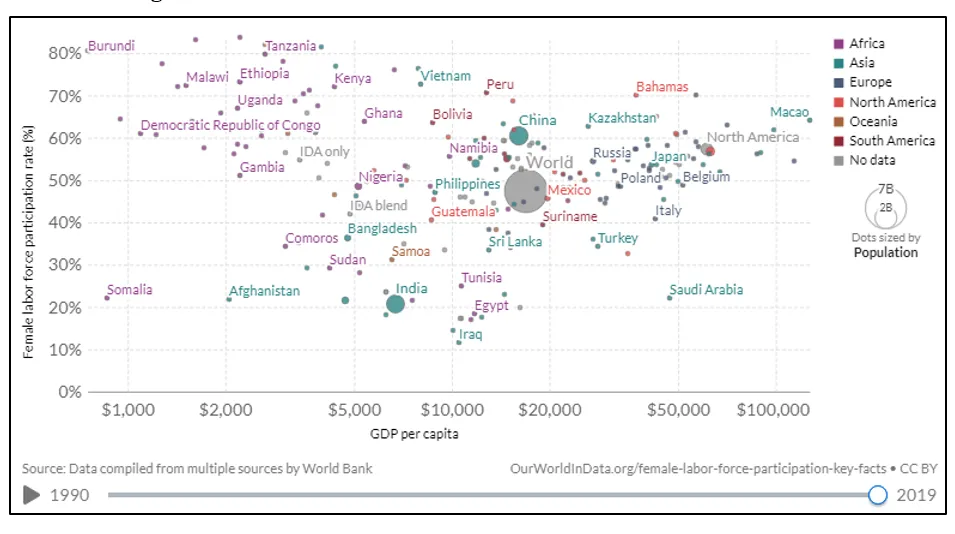
Introduction
Over the past three years, two global events, namely the COVID-19 pandemic and the Ukraine crisis, have destroyed economies and the global market. Early measures to curb the spread of the virus along with the more recent sanctions on Russian oil and gas have together affected supply chains and weakened labour markets. The effects of this began with low-paying, unstable roles primarily occupied by women. While the Global Value Chain (GVC) boosts exports and productivity, access to and benefits of participation vary for men and women. Women are often constrained to the informal roles which are the first to be affected in times of crisis thereby exposing GVCs as gendered-structure. Thus, as part of the recovery from the pandemic and the Ukraine crisis, female participation in the GVC must be included as one of the initiatives. This brief makes a case for the same in a two-fold manner: First, to highlight the current impact of women’s unemployment on supply chains and second, to showcase the economic benefits of including them as agents contributing to the broader development.
Understanding GVC as Gendered-Structures
Figure 01. Female Labor Force Participation Rates by National per Capita Income, 2019

Source: Data compiled from multiple sources by World Bank
GVC accounts for almost 50 percent of global trade. Yet, the proportion of women is significantly lower as compared to men. From the above chart, it can be seen that female labour force participation is highest in some of the richest and poorest countries, while lowest in middle-income countries. There are two reasons for this: First, the two and perhaps only competing sectors for female participation are garment and agriculture industries in middle-income countries, according to the Trade in Value Added (TiVA) database. Both of these sectors compromise unskilled, low-paying jobs. Second, due to social stigma, domestic obligations, and differential access to and control over resources, moving into secure jobs is more challenging for women. The gendered interaction with socio-economic inequalities exacerbates women’s disadvantages leading to gender-intensified constraints in the GVC.
In developing countries, women make up 33.2 percent of the workforce of firms that trade internationally, as compared with just 24.3 percent of non-exporting firms. Trade liberalisation exposes women to a greater accumulation of skills and education. Improved women’s rights promote trade, thus creating a virtuous cycle between gender equality and trade. Additionally, women constitute 36.7 percent of the workforce of GVC firms, which is 10.9 percentage points more than the proportion for non-GVC. However, on account of the pandemic, 54 percent of overall job losses were disproportionately faced by women. To make a case for why this matters, not only do women’s economic contributions need to be identified, but also tabulate the economic loss because of their absence. Their contribution will be looked at in two key industries: Agriculture and the retail sector.
Women as economic actors
If a firm engages in international trade, women’s share of total manufacturing wages rises by 5.8 percentage points on average, through a combination of increased employment and higher salaries. Women working in GVC enjoy a certain degree of job security with a 10-percentage-point higher probability of holding jobs as opposed to women working in sectors not integrated into the GVC. Trade also creates incentives for countries to improve women’s access to crucial resources such as technology and education. Employment opportunities arising from education provide social benefits for women to enjoy delayed family planning, as in the case of Bangladesh where young girls gain an additional 1.5 years of schooling. An additional number of educated workers adds to an economy’s productivity, giving it a competitive advantage. This in turn makes an economy more valuable, improving its overall GDP. A Goldman Sachs report makes a case for the same, wherein even a single point increase in female education raises the average GDP level by 0.37 points and the annual growth rate by 0.2 points on average. The same benefits can be applied to the agriculture sector as well.
Women contribute 43 percent of the global agricultural labour force. If women had the same access to production facilities as men, agricultural output in 34 developing countries could increase by an estimated 4 percent on average. This would reduce the number of malnourished people by 17 percent, resulting in up to 150 million fewer hungry people. Thus, increased female participation creates a beneficial employment-productivity cycle improving a country’s overall economic position and individual poverty traps. The World Bank proved this by looking at Latin America and the Caribbean wherein the female labour market income contributed to a 30 percent reduction in extreme poverty over 10 years. Thus, societies with greater equality not only provide better socioeconomic opportunities but also tend to grow faster.
As a commitment to ensuring greater gender equality, G20 countries are looking to reduce the gap by 25 percent by 2025. This could add US $28 trillion in GDP growth to the global economy by then and unlock large potential tax revenues. Global tax revenue could increase by US$ 1.5 trillion, most of it in emerging (US$ 990 billion) and developed countries (US$ 530 billion). Speaking of developing countries, in India, the female participation rate is only at 24 percent, placing it amongst the lowest in developing nations. If female participation rates are improved by 2025, the Indian economy could grow by an additional 60 percent, adding US $2.9 trillion to the formal economy. Thus, on account of recovering from the pandemic and attaining SDGs, female labour participation should be one of the areas G20 countries must focus on.
Conclusion
While individual countries and the global community are looking towards a sustainable future, it is important to note that inclusivity and equality are important components of the ‘Recover Stronger’ initiative. Including the dismantling of GVCs as gendered structure as part of recovery, provides women with opportunities for skill development, job security, and higher wages. On the other hand, from the aforementioned reasons, it can be seen that female participation in the GVC unlocks access to new markets and increases innovation, which adds to GDP growth. Thus, gendered policymaking is more than a social cause; it is economically beneficial and can improve the global economy and trade, creating a positive circle of development.
The views expressed above belong to the author(s). ORF research and analyses now available on Telegram! Click here to access our curated content — blogs, longforms and interviews.





 PREV
PREV


